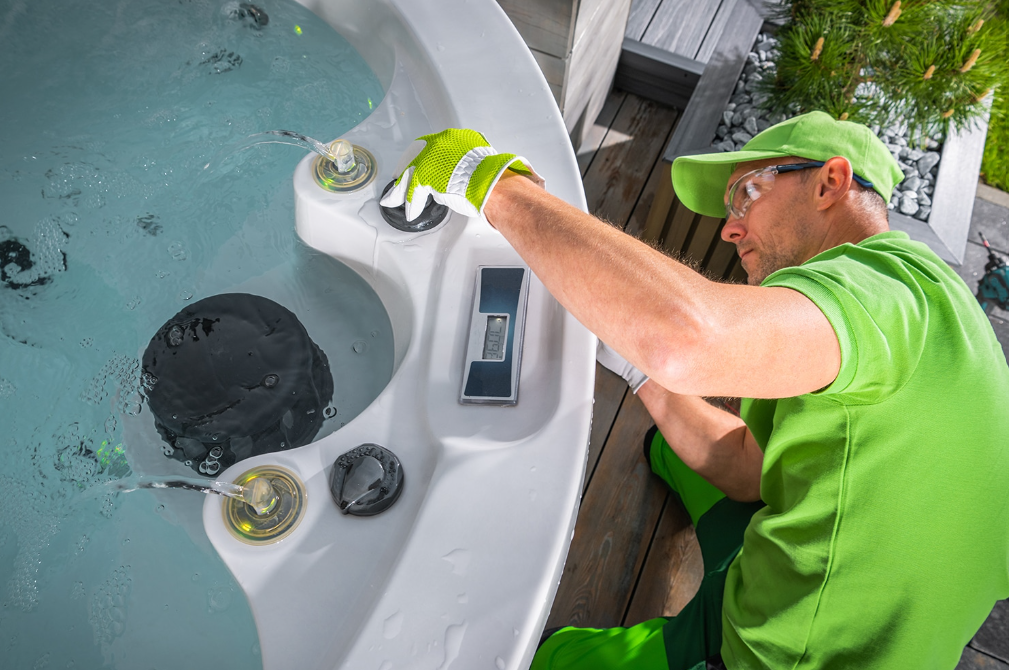
Hot tub maintenance is an essential aspect of ownership. Whether you’re enjoying your hot tub for relaxation, hydrotherapy, or social gatherings, proper maintenance ensures that your spa remains safe, clean, and functional. Neglecting routine care can lead to bacteria buildup, unpleasant odors, costly repairs, and a diminished soaking experience. In this guide, we’ll cover everything you need to know about maintaining your hot tub for optimal performance and enjoyment.
- Why Is Hot Tub Maintenance Important?
Maintaining your hot tub involves more than just keeping it looking clean. It is about ensuring water safety, equipment longevity, and an overall pleasant experience. The main benefits of regular maintenance include:
Water Quality: Regular maintenance helps keep the water clear, balanced, and free from harmful bacteria or contaminants.
Longevity: Well-maintained hot tubs can last for years, preventing wear and tear on vital components.
Safety: Unclean water can pose health risks, from skin irritations to more serious infections.
Cost Efficiency: Regular checks help catch small problems before they turn into expensive repairs.
- Regular Water Chemistry Checks
Keeping your hot tub’s water chemistry balanced is a fundamental part of hot tub maintenance. A properly balanced hot tub ensures the water is clean, safe, and comfortable to soak in. There are three main elements to monitor:
pH Levels: The pH should be between 7.4 and 7.6. Too low, and the water becomes acidic, causing corrosion to the equipment. Too high, and the water may become cloudy and cause skin irritation.
Alkalinity: Total alkalinity stabilizes the pH. Aim for levels between 80-120 ppm (parts per million) to keep pH fluctuations in check.
Sanitizers (Chlorine or Bromine): These chemicals kill bacteria and keep your water safe to use. Chlorine should be between 1-3 ppm, while bromine levels should be 3-5 ppm.
Tip: Use a reliable test kit or testing strips to regularly monitor these levels. Checking the water chemistry two to three times per week is a good practice.
Do you want to visit Haridwar? travel agents in Haridwar is the right place to plan your tour. You can book your tour from here.
- Filter Maintenance: Clean or Replace
Hot tub filters play a vital role in ensuring proper water circulation and maintaining clean water. They catch dirt, debris, and oils from the water, preventing them from recirculating. To keep your filters functioning optimally:
Clean Filters Weekly: Rinse them off with water or use a filter cleaner to remove any buildup.
Deep Clean Monthly: Soak the filters in a filter cleaning solution to remove oils and debris.
Replace When Necessary: Depending on usage, filters should be replaced every 12-24 months. If the filter looks worn or damaged, it’s time for a replacement.
Tip: Have a backup set of filters on hand so you can rotate them between cleanings and keep your hot tub running efficiently without downtime.
- Draining and Refilling Your Hot Tub
Even with regular chemical balancing and filter cleaning, the water in your hot tub should be drained and replaced periodically. Draining and refilling your hot tub prevents chemical buildup, introduces fresh water, and keeps the spa experience enjoyable. Here’s a general guideline:
Frequency: Drain your hot tub every 3-4 months, depending on usage.
Procedure:
Turn off the power to the hot tub.
Connect a garden hose to the drainage valve and direct the water away from your home.
Let the tub drain completely, then clean the surface using a spa surface cleaner.
Refill the tub, being mindful to check the water chemistry and adjust it accordingly.
Tip: Before draining, use a line flush cleaner to remove biofilm and other contaminants from the plumbing lines.
- Hot Tub Cover Maintenance
A well-fitted, insulated cover helps protect your hot tub from debris, maintains the water temperature, and reduces energy costs. However, the cover itself needs some care:
Clean the Cover Monthly: Use a gentle cleanser and a non-abrasive cloth to clean the cover. Avoid harsh chemicals that may damage the material.
Condition the Cover: Applying a UV protectant can help prevent cracking and fading due to sun exposure.
Inspect for Damage: If you notice tears, mold, or water saturation (the cover becomes unusually heavy), it might be time to replace it.
Tip: Invest in a cover lift to make removing and replacing the cover easier, reducing wear and tear.
Do you want to visit char dham? char dham tour operator is the right place to plan you Char Dham tour. You can book you tour from here.
- Inspecting Hot Tub Equipment
Routine inspection of your hot tub’s components can save you from costly repairs down the road. While some tasks require a professional, here are a few things you can monitor:
Jets: Check for proper water flow. If the jets seem weak or uneven, it could indicate a blockage or need for cleaning.
Pumps and Motors: Listen for any unusual noises or vibrations, which could signal an issue. If you notice any leaks around the motor or pump, consult a technician.
Heater: Ensure that the water is heating up correctly. If it takes longer than usual or fails to reach the desired temperature, it might be time for a service.
Electrical Components: Check all lights and controls to ensure they are functioning properly.
Tip: Set a regular schedule for these inspections, and if something seems off, address it immediately to prevent bigger issues. Visit us.
- Shock Treatments for Hot Tub
Even with regular chemical maintenance, it’s important to shock your hot tub occasionally. Shocking involves adding a large dose of oxidizer (usually chlorine or non-chlorine shock) to break down organic contaminants like sweat, oils, and lotions that regular sanitizers might miss.
Frequency: Shock your hot tub once a week or after heavy use.
Types of Shock:
Chlorine-based shock: Ideal for killing bacteria and algae.
Non-chlorine shock: Better for breaking down organic material without raising sanitizer levels.
Tip: Always follow the manufacturer’s instructions for shock treatments and allow the chemicals to dissipate before using the hot tub.
- Seasonal Hot Tub Maintenance Tips
Your hot tub’s maintenance needs can vary based on the season. Here are some seasonal tips to keep in mind:
Winter:
Ensure your hot tub is insulated properly to reduce heating costs.
Consider using antifreeze in the plumbing if you live in a region where temperatures drop below freezing.
Summer:
Increase the frequency of water chemistry checks as heat can lead to rapid chemical changes.
Shade your hot tub to prevent excess heat from evaporating chemicals.
Tip: Use your hot tub year-round by adjusting the settings and maintenance routine according to the season.
- Setting a Consistent Maintenance Schedule
Consistency is key when it comes to hot tub maintenance. By establishing a regular maintenance routine, you can avoid last-minute fixes, unexpected repairs, and unscheduled downtime. Here’s a suggested weekly routine:
Daily: Ensure the hot tub cover is securely in place, and check the water temperature.
Weekly: Test the water chemistry, clean the filters, and inspect the jets.
Monthly: Deep clean the filters, clean the cover, and inspect for any equipment issues.
Quarterly: Drain and refill the water, perform a thorough inspection of all components, and replace filters if necessary.
Conclusion
Proper Hot Tub Maintenance is the key to enjoying a clean, safe, and relaxing experience. By staying on top of water chemistry, cleaning filters, inspecting equipment, and setting a consistent maintenance routine, you can extend the lifespan of your hot tub and get the most out of your investment. For more tips and products to help with your maintenance routine, visit One Hot Tub’s Hot Tub Maintenance Section.

